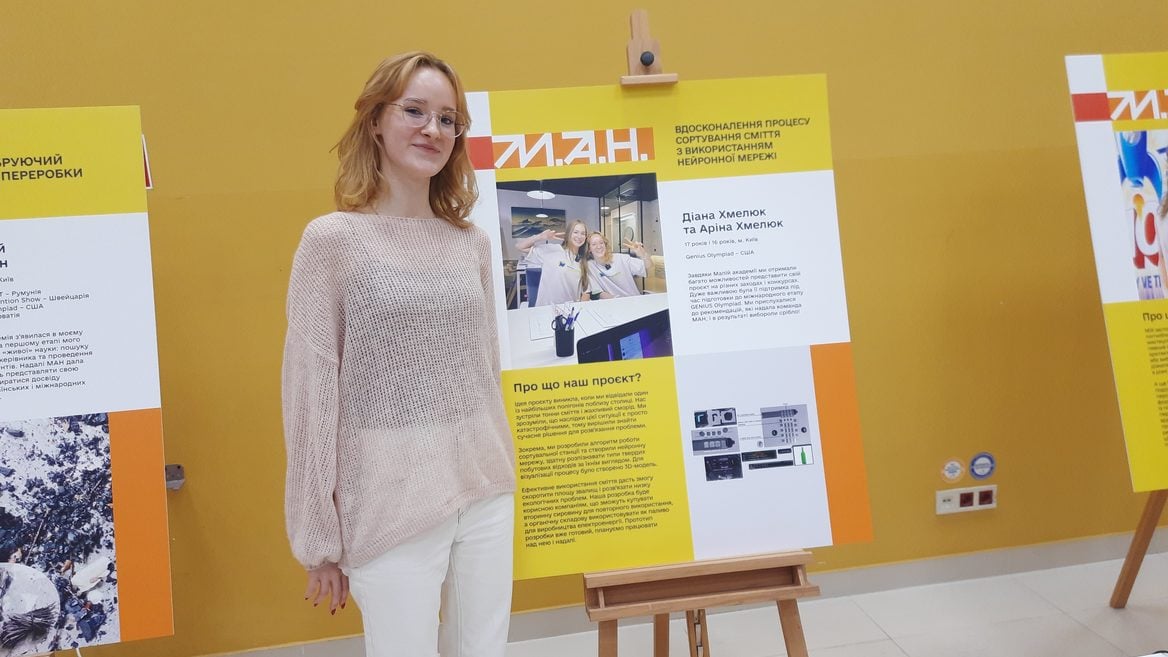

Photo: dev.ua
Dev.ua reports this.
What is the problem?
The girls' grandma lives close to Pidhirtsy, where there is a dump for regular trash. The smell from that dump got the sisters thinking about the waste sorting project.
As part of a project for the international Genius competition, the girls, who were students at the National Academy of Sciences, produced a film about the landfill.
"It was not the most pleasant impression. The emotions of what I saw forced me to do something about it because it is impossible to live there anymore," Diana recalls.
While developing the project idea, the sisters learned that there is an incineration plant in Kyiv.
"But it also burns plates and polyethylene, which harms the environment," Diana notes.
What is the solution?
At that point, the girls decided to take action to help reduce the amount of garbage or at least recycle a portion of it. In addition, the project included a feature to construct a complete facility that would sort and incinerate solely organic materials.
Diana has already graduated from school and is in her first year at the Faculty of Informatics and Computer Engineering at the Kyiv Polytechnic Institute named after Ihor Sikorskyi. Arina is currently in her final year at the Kyiv Polytechnic Lyceum, and both girls are part of the Junior Academy of Sciences.
Diana mentioned that she and her sister collaborated on the entire project. She handled the neural network development while Arina worked on the algorithm and 3D model for the station.
How does it work?
As they say, the robotic station of the Khmeliuk sisters goes through several stages during waste sorting:
These conveyors must be equipped with manipulator robots and sensors with a neural network. When the model recognizes an object, the manipulator moves the garbage to the appropriate tank.
"We added neurons that recognize exactly what we need, not just a wall or a ceiling, but plastic, glass, etc.," the girl explained.
The sisters chose the Exception neural network architecture for their project, adapting it to recognize materials such as glass, plastic, and other types of waste. Currently, the neural network's accuracy is 91%, and the sisters plan to improve it to identify materials of different types and colors more accurately.
Environmental and economic advantages
The station is aimed at:
"Now, garbage in Ukraine is a resource that just lies in landfills, but it can be useful," Diana emphasizes.
The sisters estimated that it would cost approximately $10 million to create a fully automated sorting station from scratch, the largest cost being the construction of the complex and sorting equipment.
"But the raw materials are free, and the electricity production is quite profitable. The investment will pay off quickly," Diana is sure.
Now, the sisters are working on a prototype and plan to patent their development. The girls strive to find investments to implement the project in reality.
Американський президент Дональд Трамп домагався особистих переговорів з українським лідером Володимиром Зеленським у Ватикані під… Читати більше
Президент Володимир Зеленський заявив, що скоро буде вже пів сотні днів, як кремль ігнорує пропозицію… Читати більше
На Курщині військові Сил спеціальних операцій знищили групу російських морських піхотинців та взяли двох полонених.… Читати більше
Колишній лідер Демократичної партії Лі Чже Мьон у неділю, 27 квітня, переміг на президентських виборах… Читати більше
У Херсоні внаслідок ворожих ударів керованими авіабомбами пошкоджені приватні та багатоквартирні будинки, медичні та освітні… Читати більше
Військові Повітряних сил розповіли, як оператори зенітного ракетного комплексу NASAMS за один протиповітряний бій знищили… Читати більше
Цей сайт використовує Cookies.